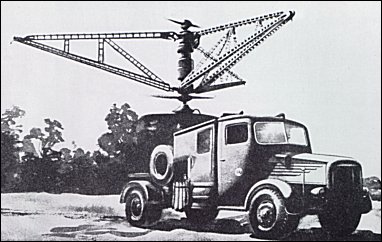
| AEG 1997 |  |
 |

| AEG 1997 |  |
 |
|
The A.E.G. helicopter designed by R. Schmidt in some respects resembled the Petroczy-Karman aircraft used in World War I. The A.E.G. was attached to the ground by a system of three tethering cables which helped to stabilize it so that it could be used as an observa-tion post or, if need arose, as a support for an aerial. The co-axial contra-rotating two-bladed rotors were driven by an electric motor located between them and fed with power through the three anchoring cables attached to girder-type arms fixed above the upper rotor. These tethering girders supported the observer's cabin; in the event of engine failure, the observer escaped by using a parachute blown into the air by a powder charge. The helicopter could be transported to the point where it was to be used in a special lorry fitted with a launching stand and a control desk. P.Lambermont "Helicopters and Autogyros of the World", 1958
As early as the First World War, consideration was given to more convenient means of aerial observation than captive balloons. Many of these new ideas centred around rotating wing aircraft, the most noteworthy in this sphere being the Hungarian Petroczy-Karman design for a captive helicopter having three engines driving two contra-rotating coaxial rotors. R. Schmidt worked along similar lines from about 1933 for the large German electrical concern, Allgemeine Elektrizitats-Gesellschaft (AEG), and this work was finalized in 1940 in the shape of a tethered electric helicopter for use as an aerial observation or support post for the army. The AEG helicopter had two two-blade rotors mounted co-axially, one being attached to the shaft and one to the shell of a 200hp electric motor, thus giving contra-rotation. Three fixed arms were attached above the upper rotor, and these arms not only supported the cabin below but served as the cable attachment points for tethering. The three tethering cables were, in fact, also used to feed power to the motor from a ground source via the control panel located in the special launching and transporting truck. The observer could make an emergency escape by using a parachute which was explosively blown into the air. Despite successful trials, the AEG helicopter does not appear to have been adopted for military use, probably because of the impracticability of always having to find a considerable electric current supply. J.R.Smith, Antony L. Kay "German Aircraft of the Second World War", 1972
Engineer R. Schmidt of the Allgemeine Elektrizitatsgesellschatt (AEG) had been working since 1933 on a helicopter that was intended for use as a captive observation platform that could be built onto a truck. It was a device with two coaxial opposed airscrews driven by electric motors of 50, later 100 and 200 horsepower. Lift ranging from 450 to 1250 kilograms was attained. But it was never used by the armed forces. H.J. Nowarra "German Helicopters 1928-1945", 1990 * * *
|